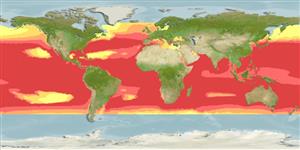Environment: milieu / climate zone / تغييرات عمق / distribution range
بوم شناسي
دريايي pelagic-oceanic; اقیانوس رو; تغييرات عمق 0 - 260 m (Ref. 9340), usually 0 - ? m (Ref. 55287). Tropical; 15°C - 30°C (Ref. 168); 63°N - 47°S, 180°W - 180°E
Cosmopolitan in tropical and warm-temperate waters. Not found in the Black Sea. Highly migratory species,
Length at first maturity / Size / Weight / سن
بلوغ: Lm 41.3, range 40 - 45 cm
Max length : 110 cm FL جنس نر / بدون خواص جنسي; (Ref. 89423); common length : 80.0 cm FL جنس نر / بدون خواص جنسي; (Ref. 168); بيشينه وزن گزارش شده: 34.5 kg (Ref. 168); بيشينه سن گزارش شده: 12 سال ها (Ref. 168)
خارهاي باله پشتي (کل) : 14 - 16; شعاع نرم باله پشتي (کل) : 14 - 15; خارهاي باله مخرجي: 0; شعاع نرم باله مخرجي: 14 - 15; مهره ها: 41. This species is distinguished by the following characters: body fusiform, elongate and rounded; teeth small and conical, in a single series; gill rakers on first gill arch numerous, 53-63; D1 XIV-XVI, dorsal fins separated by a small interspace (not larger than eye), the second followed by 7-9 finlets; anal fin followed by 7-8 finlets; pectoral fins short, with 26-27 rays; 2 flaps (interpelvic process) between pelvic fins; body scaleless except for corselet and lateral line; a strong keel on each side of caudal-fin base between 2 smaller keels. Colour of back dark purplish blue, lower sides and belly silvery, with 4-6 very conspicuous longitudinal dark bands which in live specimens may appear as discontinuous lines of dark blotches (Ref. 9684).
Body shape (shape guide): fusiform / normal; Cross section: oval.
Found in offshore waters; larvae restricted to waters with surface temperatures of 15°C to 30°C (Ref. 6390). Exhibit a strong tendency to school in surface waters with birds, drifting objects, sharks, whales and may show a characteristic behavior like jumping, feeding, foaming, etc. Feed on fishes, crustaceans, cephalopods and mollusks; cannibalism is common. Spawn throughout the year in the tropics, eggs released in several portions (Ref. 35388). Eggs and larvae are pelagic (Ref. 6769). Preyed upon by large pelagic fishes (Ref. 6885). Also taken by trolling on light tackle using plugs, spoons, feathers, or strip bait (Ref. 9684). Marketed fresh, frozen or canned (Ref. 9340, 9684 ); also dried-salted and smoked (Ref. 9987).
In tropical waters, reproductively active female skipjack tuna spawn almost daily.
Collette, B.B. and C.E. Nauen, 1983. FAO Species Catalogue. Vol. 2. Scombrids of the world. An annotated and illustrated catalogue of tunas, mackerels, bonitos and related species known to date. Rome: FAO. FAO Fish. Synop. 125(2):137 p. (Ref. 168)
وضعيت در فهرست قرمز IUCN (Ref. 130435: Version 2024-2)
خطر برای انسان ها
Reports of ciguatera poisoning (Ref. 4690)
استفاده انسانی
ماهي گيري – شيلات: با ارزش تجاري بالا; ماهي ها ي سرگرم كننده: بله
ابزارها
گزارش های ويژه
بارگيری XML
منابع اينترنتي
Estimates based on models
Preferred temperature (مرجع
123201): 13.3 - 29, mean 26.2 °C (based on 8934 cells).
Phylogenetic diversity index (مرجع
82804): PD
50 = 1.0000 [Uniqueness, from 0.5 = low to 2.0 = high].
Bayesian length-weight: a=0.01072 (0.00958 - 0.01198), b=3.10 (3.07 - 3.13), in cm total length, based on LWR estimates for this species (Ref.
93245).
Trophic level (مرجع
69278): 4.4 ±0.5 se; based on diet studies.
Generation time: 2.1 (1.8 - 2.4) years. Estimated as median ln(3)/K based on 57
growth studies.
جهندگی (مرجع
120179): متوسط, كمينه زمان لازم براي دو برابر شدن جمعيت 4/1 – 4/4 سال (K=0.3-0.5; tm=2-3; tmax=12; Fec=61,516).
Prior r = 0.52, 95% CL = 0.35 - 0.79, Based on 9 full stock assessments.
Fishing Vulnerability (Ref.
59153): Moderate vulnerability (38 of 100).
🛈
Climate Vulnerability (Ref.
125649): Moderate vulnerability (41 of 100).
🛈
Nutrients (Ref.
124155): Calcium = 155 [39, 307] mg/100g; Iron = 2.27 [0.81, 7.03] mg/100g; Protein = 22.3 [20.8, 23.6] %; Omega3 = 0.45 [0.22, 1.05] g/100g; Selenium = 87.4 [31.2, 237.6] μg/100g; VitaminA = 6.64 [1.25, 40.76] μg/100g; Zinc = 1.54 [0.37, 3.23] mg/100g (wet weight); based on
nutrient studies.
